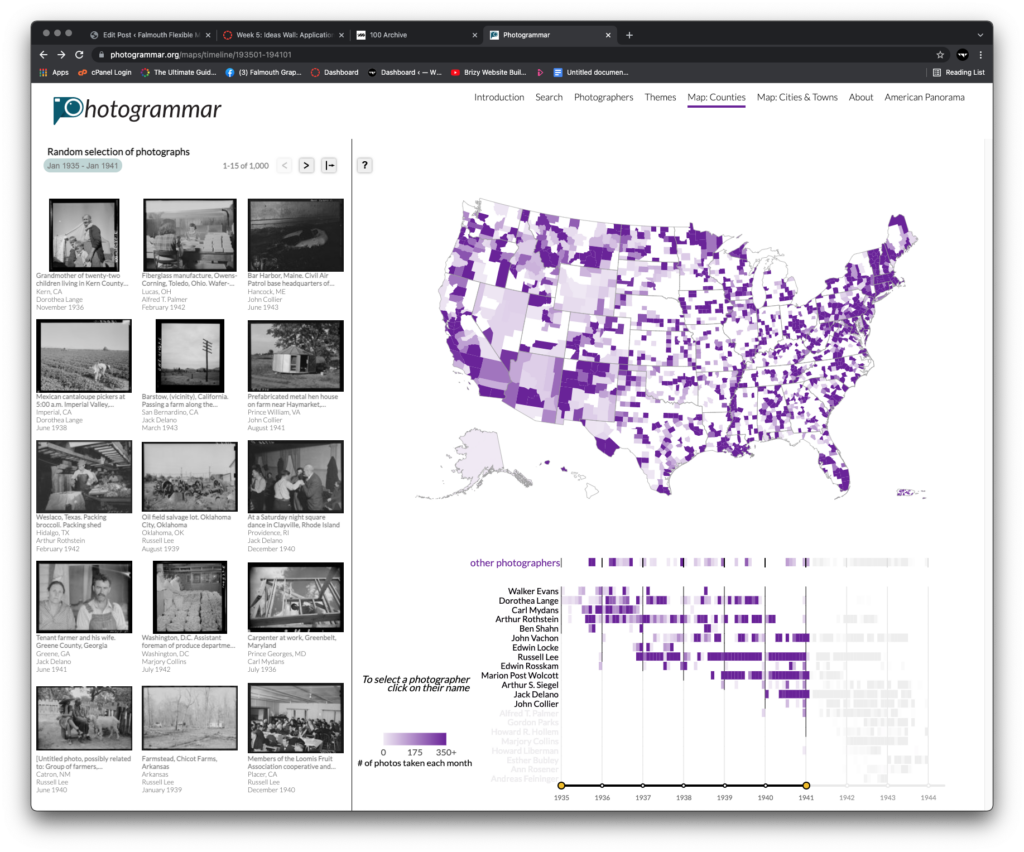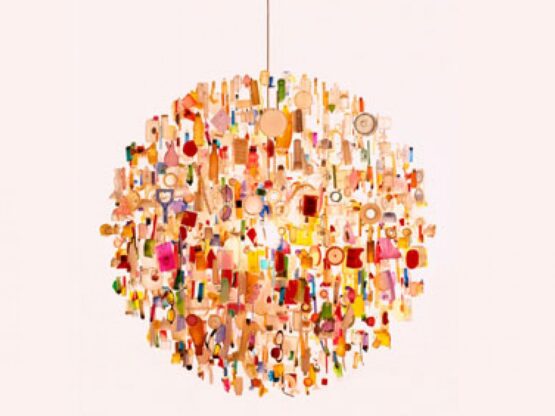Selecting, building project experience, competitiveness, case studies
REFLECTIONS ON LECTURES AND SOURCE MATERIAL
LECTURE
Q: How do you research and identify new industry projects or opportunities that you would like to participate in?
In following the lecture it was clear that there were opposing methods/preferences for identifying potential new clients/industries to work in and how opportunities arise. There seem to be a couple of universal entry points for return business. By actively seeking to target a particular industry sector through specialist knowledge, or by word of mouth with clients coming to you for your experience. I think the size of the business and number of years it has been in the industry has some bearing on this.
Most of the lecturers agree that it's actually hard to the point of near impossible to break into a sector where you have little or no experience and as a result of this they build on their specialist knowledge and internal research base to procure work in a field that they are already completely immersed in. I find this approach strange in the sense that if you work for a similar product or client their could be a conflict of interest.
It was interesting to hear Studio Dunbars Wouter Dirks talk about their involvement with industry conferences and organisations as a way of increase and getting your profile out there. Liza Enebeis and the team have certainly presented their work on the global stage over the past few years (pre-pandemic of course), and even if clients aren't aware of SD and Dept's digital work, then designers are or should be. Accept and Proceed take a more specific approach to who they choose to work with. Their interests lie in passion projects that have societal impact and they seek to partner with and help 'woke' visionaries; using design to have an impact and make things better in the world. They use the self-initiated projects as a tool for gaining new business from their target client base.
Studio Dunbar and Eden Spiekermann have established themselves to the point that clients come to them with projects based on their industry experience. It is also interesting that Torsten Posset talks briefly about growing into a multi-disciplinary, full service agency. I think most design companies can no longer rely on pure graphics to solve a problem and a breadth of skills and industry channels is important for a practice to thrive. However, if you are a small practice this need to be diverse in your skillset can be somewhat daunting. The way round this is to build a team that you can collaborate with on certain projects to try to compete at a higher level.
TAKE OUTS
— Don't be afraid to be multi-disciplinary, if you don't have the skills in-house look for ways to collaborate and outsource the project.
— It's good to understand the medium of communication in order to be able to control the process.
— It is a strength in industry terms to specialise and build a knowledge base, and helps to gain reputation and new business.
— However, it can also be exciting to jump in and learn as you go. It can be more rewarding and the outcome more interesting.
— Find a problem you want to solve and that matches your skillset.
— Collaborate, collaborate, collaborate.
— Use self-initiated projects to grow your practice and gain visibilty.
— Workshops = Better market research and insight.
— Get involved in industry organisations and design conferences.
—
RESOURCES
TAKE OUTS
— Understand the problem and then look for simple play, surprise, pleasure and delight.
— Look for play both graphically and with your tone of voice.
— Shut up and listen.
— Sometimes the shortest route to an idea is the right one.
— Think about the end user/audience.
— Obsession = success.
— Inspiration can be a moment of surprise anywhere, anytime, anyplace from anything.
"It's not hard to be successful, but it's hard to maintain success".
Jessica Hirsche
—
Workshop Challenge
Read, research and analyse the four preselected ‘Industry Set’ project briefs and write short preliminary notes about each option. Post the preliminary notes onto your blog.
BRIEF 1: CREATIVE CONSCIENCE COMPETITION BRIEF
Finding ways to improve the lives of others and improve mental health is something that is close to home as I myself have suffered from depression and its effects all my adult life. In approaching this project further research would need to be done as it is, at the moment hard to see how I could for instance effect change in a global conflict zone (maybe there is something in dealing with refugee PTSD).
I see this as an issue that hasn't been addressed on a basic local level with prohibitive psychotherapeutic services due to cost, doctor's that are too willing to prescribe medication and also a work system that will not help employees have the time for mental health recovery. I am optioning this project as one of my chosen briefs as I am interested in the challenge of a live brief.
...
BRIEF 2: ADIDAS/D&AD NEW BLOOD BRIEF (CONCLUDED)
Using the power of a brand profile as a catalyst for change is an exciting and interesting approach. There are many areas of social deprivation that are crying out for organisations to create community centres to keep their young people away from crime and anti-social behaviour, and many local groups that do their best with a limited budget to provide this service. I think if I undertake this brief this would be an area I would focus on. There was an interesting project completed in the favelas of Brazil a few years ago that at this point in time I can't seem to source - It may be the Rochinas project by Toledo and Niemeyer, where a sports hall, arts centre, walkway and cable car were built. There's a film about it but at moment I can't find it...
From another perspective - many athletes lack the funding to get them to events including the Olympics - perhaps there is something in this area?
The only thing that puts me off this brief is the fact that it has been concluded and I would prefer to be challenged with either a collaboration or a live project, or both.
...
BRIEF 3: LIVE COLLABORATIVE BRIEF
This is a fully self-initiated approach answering social and ethical questions about how design can effects change through entrepreneurial thinking.
Unfortunately, with my current day to day business and only having evenings and weekends to work mon Uni work I think this isn't a practical brief for me at this point in time. However, it is definitely something I would be interested in exploring within my practice at sometime in the future.
...
BRIEF 4: THE SCIENCE MUSEUM R&D BRIEF
As my main goal as a designer would be to work for cultural organisations and the music industry, this is the project that most appeals to my design sensibilities. It is also very exciting in finding a way to engage an audience with the unseen collection and using new and emerging technologies to do so. After talking to John Stack last week in our webinar and seeing Stuart's post referring to previous students work I would see this as a speculative project. Also I am not sure whether this project will ever be realised as the project brief post by Stuart dates back to 2019. However this does not detract from the scope and level of creativity you can bring to a project like this. I am optioning this brief as a possibility for my 8 week project.
—
Select one of the ‘Industry Set’ project briefs that you would like to develop and deliver over the next eight weeks. Announce your selection on the Ideas Wall, for peer reflection.
CHOSEN BRIEF: THE SCIENCE MUSEUM R&D
I have chosen this brief for a number of reasons: 1) It fulfils my own personal goal of working on and gaining work from cultural institutions. 2) It will give me a chance to explore some new skillsets in designing for technology based platforms. 3) The UX and architecture of the brief interests me as it is about ordering information in a way that is easy to use and understand, engaging and technology driven and 4) the breadth of the archive itself.
THE IDEAS WALL
James makes an interesting point about not forgetting the 'physical' object as part of this process. What is the take-away from the site and will it make you want to return?
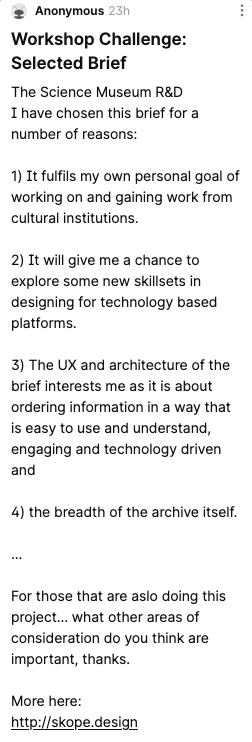
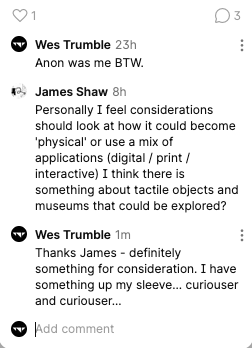
—
Research and discover three creative studios, agencies or solo practitioners who have created competing projects that are in a similar field to your chosen brief. This could be an agency that regularly work in the same field or have created a one-off project, that is similar to your selected project brief. Post a link to the three creative practitioner websites and/or competing projects onto the Ideas Wall, for peer discussion.
As I am undertaking the Science Museum brief I explored several archive sites, spending time to see how they were interacting and whether there was, as John Stack put it himself, any 'surprise or delight' to be found.
To be perfectly honest I found the majority of sites fairly pedestrian in their approach with no personality or user experience attributes. I think in the rush to digitise information the design and interaction has largely been overlooked and they have settled for a database model rather than an engaging space for user engagement.
There were a few standout designs for me - not necessarily just for the way they looked, but for the way the information was catalogued and presented. The British Online Archives, Vitra Collection, The Rijks Studio and the Digital Scholarship Labs Photogrammar project were among some of the standout online archives.
After looking and experiencing about 30 different archives I selected the following three to write my synopsis' about. Unfortunately I couldn't source the designer(s) of the Vitra site which was high up on my list of favourites.
PRACTITIONER 1: IN-HOUSE DIGITAL MEDIA TEAM AT THE V&A/PROJECT: V&A COLLECTIONS
(https://www.vam.ac.uk/collections?type=featured).
PRACTICTIONER 2: PENTAGRAM/PROJECT: COOPER HEWITT – THE COLLECTION
(https://collection.cooperhewitt.org)
PRACTICTIONER 3: SECOND STORY/PROJECT: AIGA DESIGN ARCHIVES
(https://designarchives.aiga.org/#/home)
—
Write a 200 word synopsis (600 words in total) to evaluate the strengths and weaknesses of all three competing industry professional project examples. that illustrate and support your evaluation.
The V&A Collections
The user interface of the V&A collections homepage feels intuitive and appears easy to use with proposed sections for you to explore that are both current to their exhibitions and social issues, with gender and sexuality highlighted. The search menu is broken down into easily navigable categories: Spaces, Periods/Styles, People, Featured, Materials/Techniques and Places giving you multiple points of access. Going deeper into the navigation you can select featured objects in your category with a full description, set of images and a series of meta tags that link you to similar objects made in the same period, material and so on.
While comprehensive and well designed by the in-house digital media team; it is a fairly static archive with no real use of interactivity or 3D, and there doesn’t appear to be a breadcrumb trail so you can easily go back a few steps should you wish to do so. When looking at other sites I found that the Smithsonian allows users to download files and repurpose objects for their own personal projects. For me it’s this kind of freedom given over to the users that will drive return traffic to a site.
BELOW: V&A Collections Homepage, object search by name and search result with detailed information.
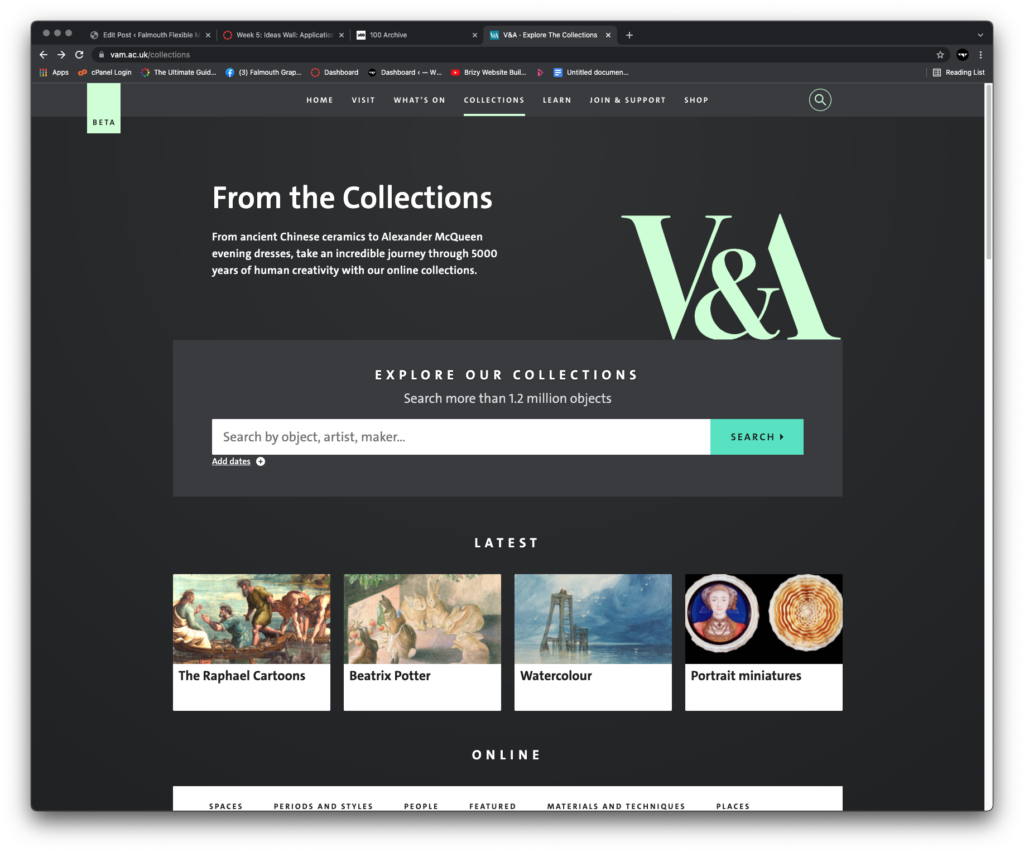
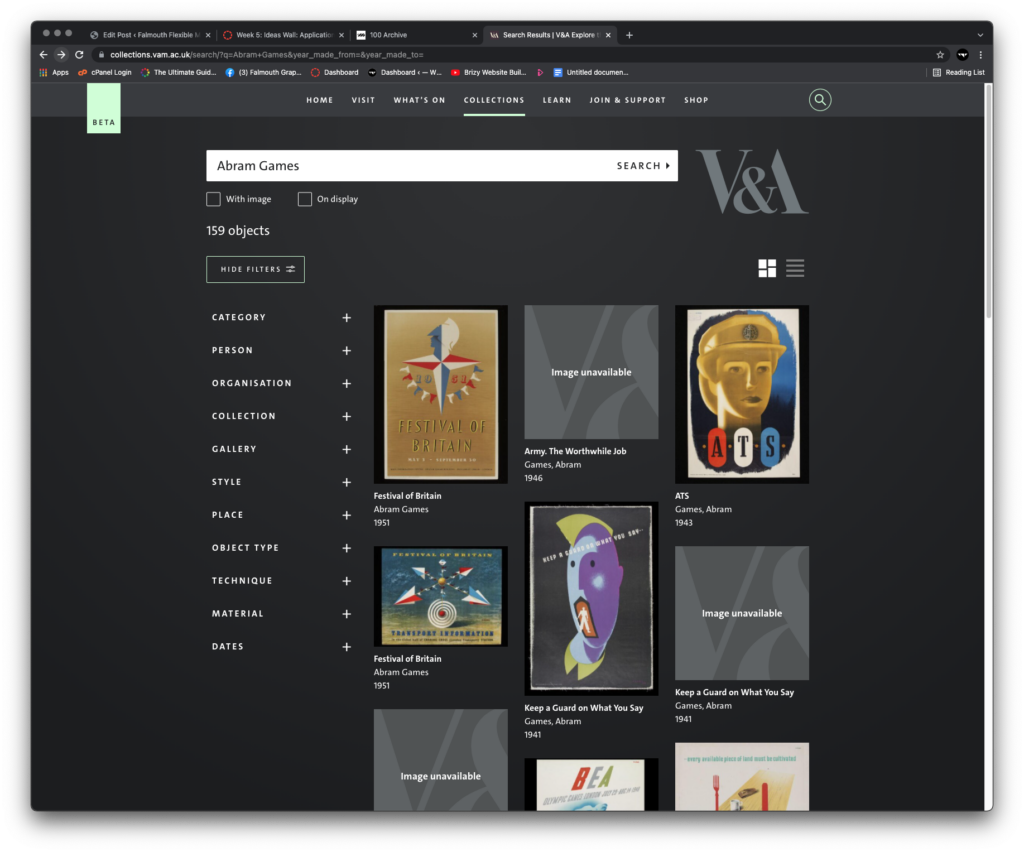
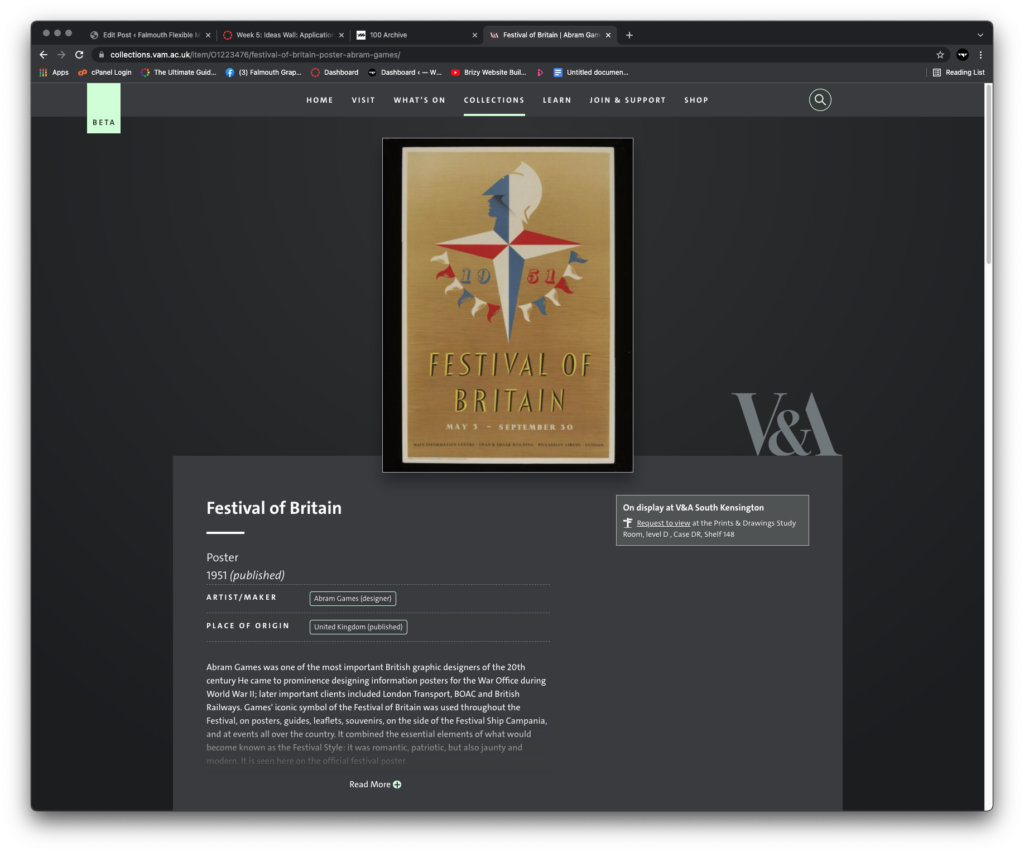
...
The Cooper Hewitt Collection
The Cooper Hewitt Collection has a similar architecture to the V&A Collection with the following positive differences: the site provides suggestions and keywords for your searches and the option to conduct an advanced search for specific objects. When searching, a multitude of options appear on the right hand side, allowing you to filter your search, and once an object is sourced you can save it to your personal account. Meta tags are used throughout enabling you to cross-reference objects in the collection and a timeline is also present giving the user a clear understanding of the period an object comes from. Within the object feed you also see similar objects from the same period which encourages the user to explore the archive further.
There are no visible breadcrumb trails, but there is a ‘Home’ and ‘Explore the Collection’ drop down visible on each page.
Once again the design of the site draws you in but with a lack of real interactivity and a limited amount of video the site feels very static. The challenge with a site that has so many objects to explore is how you maintain interest and engagement with the end user.
BELOW: Cooper Hewitt Collection Homepage, object search by name and search result with detailed information.
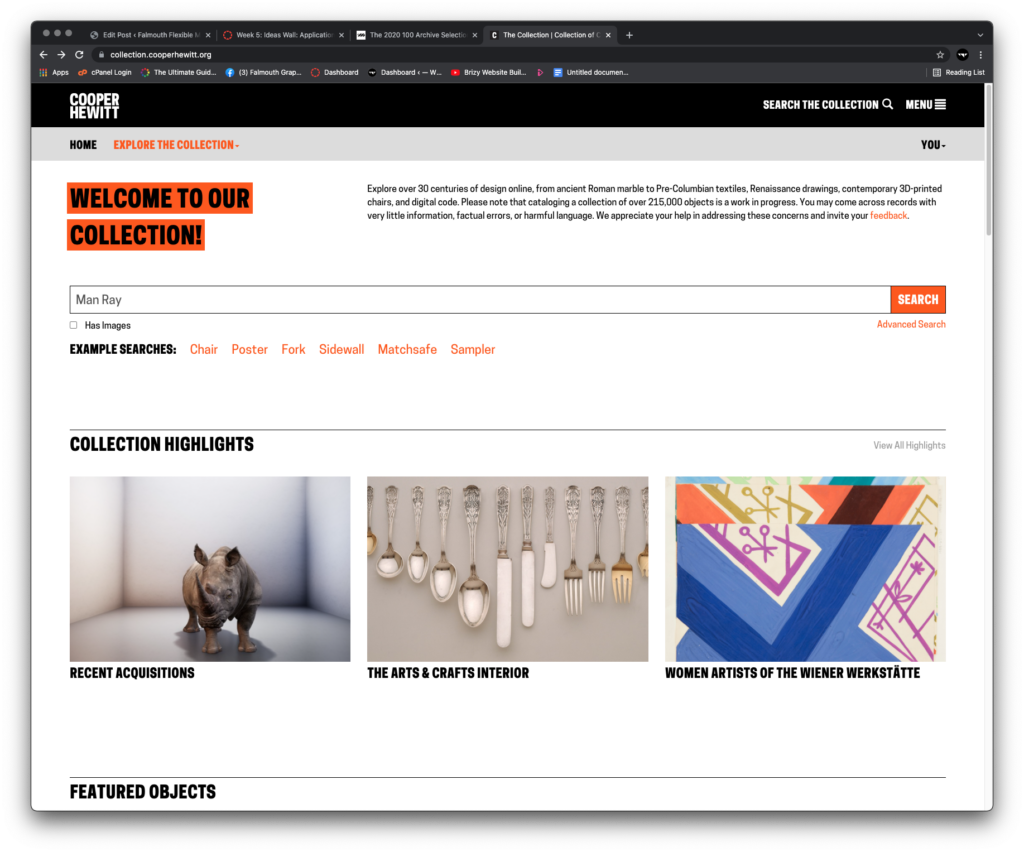
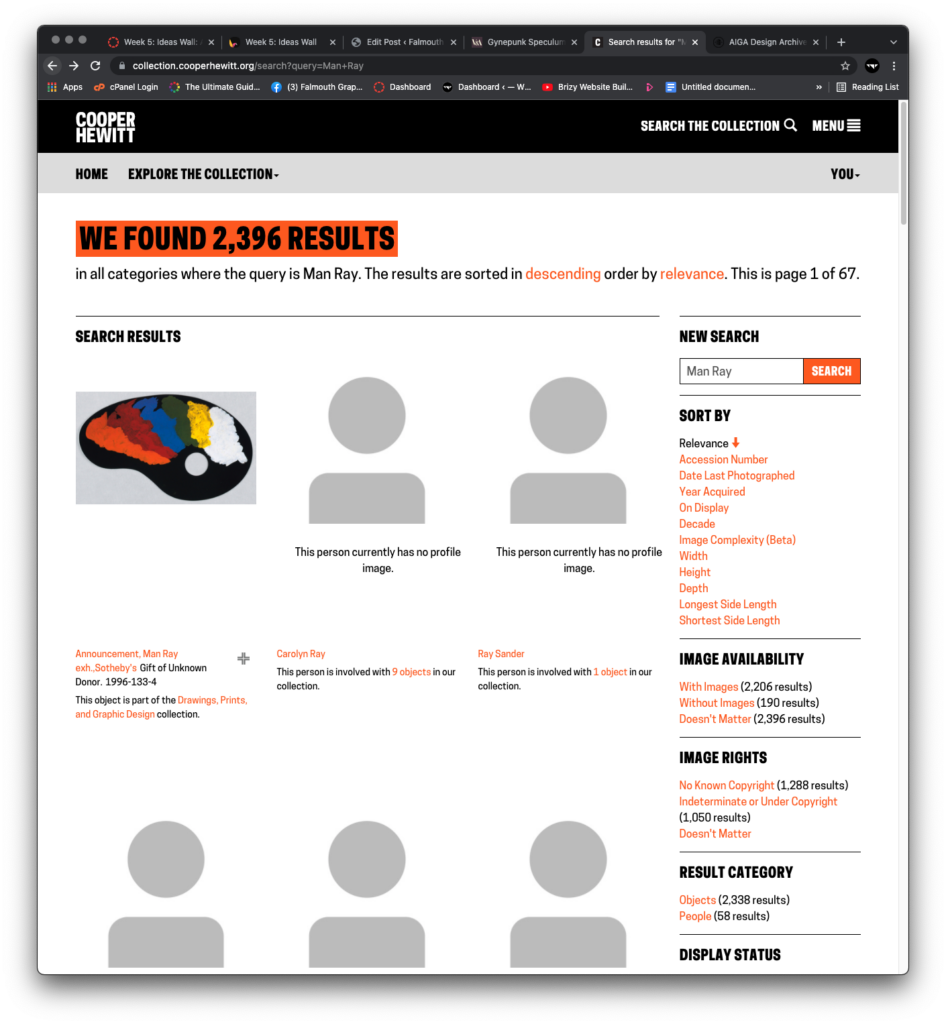
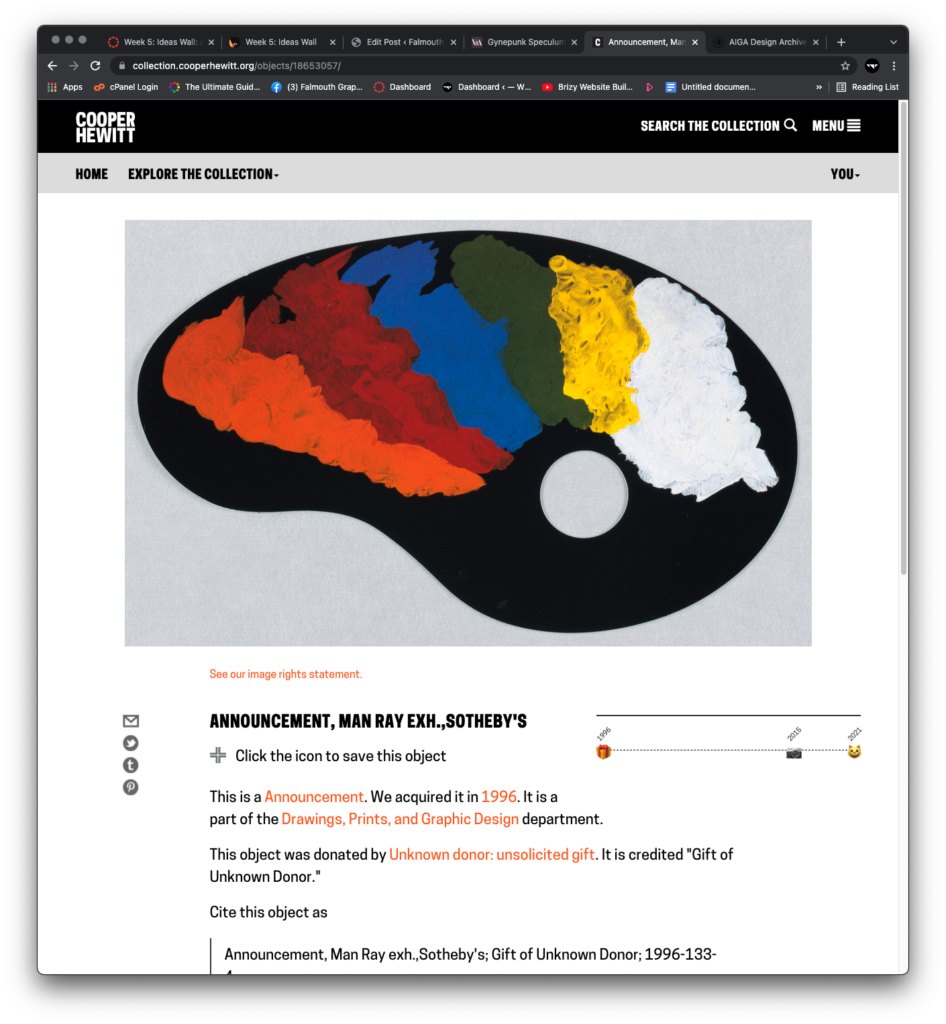
…
AIGA Design Archives
One of the things that immediately struck me about the AIGA Design Archive was the ability to search objects by colour. When John Stack mentioned this in our webinar I thought it was probably too abstract a way to search. However, when I actually see this in action it is an engaging way to explore objects within an archive and provides both surprise and delight.
Overall the design of this archive feels very dated in its execution (designed in 2010). However, there are some interesting features such as being able to browse by location. When conducting my research I came across a site by the Digital Scholarship Lab which also uses location as a method to browse it’s archive of images. This was interesting as it used physical maps to show the location of where a photograph was taken and you could navigate by clicking either the photo or the map itself.
The AIGA website uses meta tags for cross referencing, but because of the age of the build it has none of the features you’d expect from modern websites - such as parallax scrolling and there are no prompts to promote additional object searches within the site.
BELOW: AIGA Design Archives Homepage, object search by colour and colour search results page.
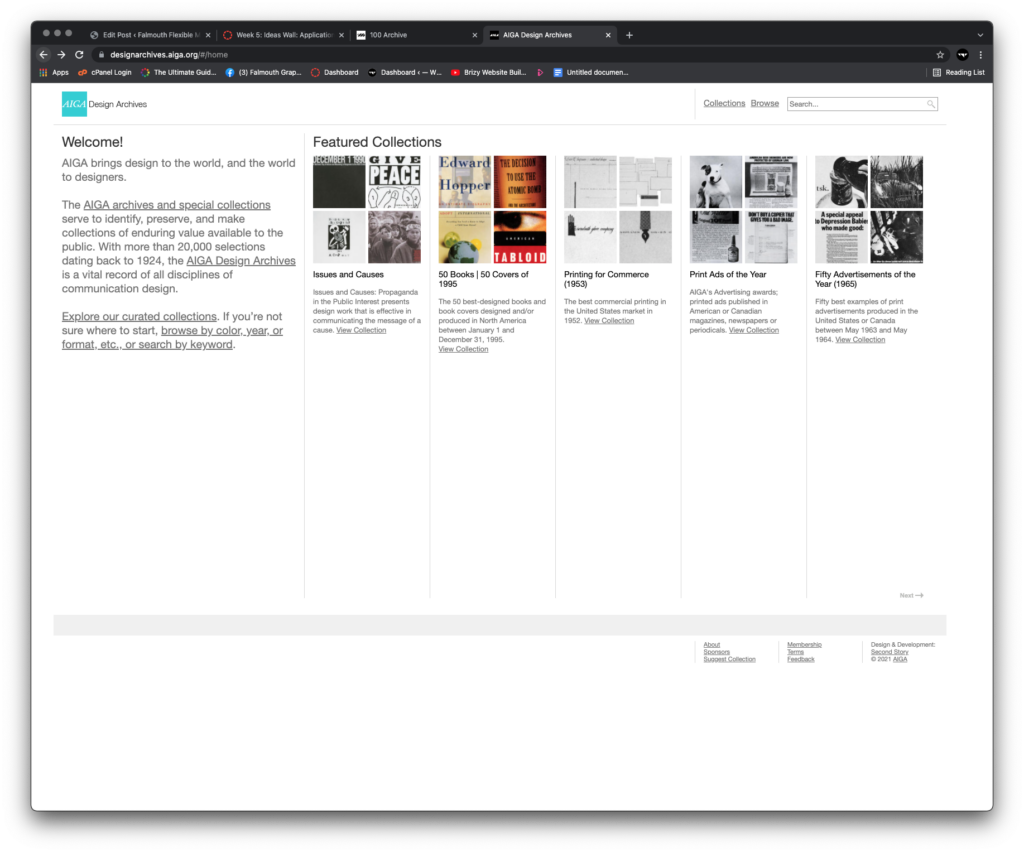
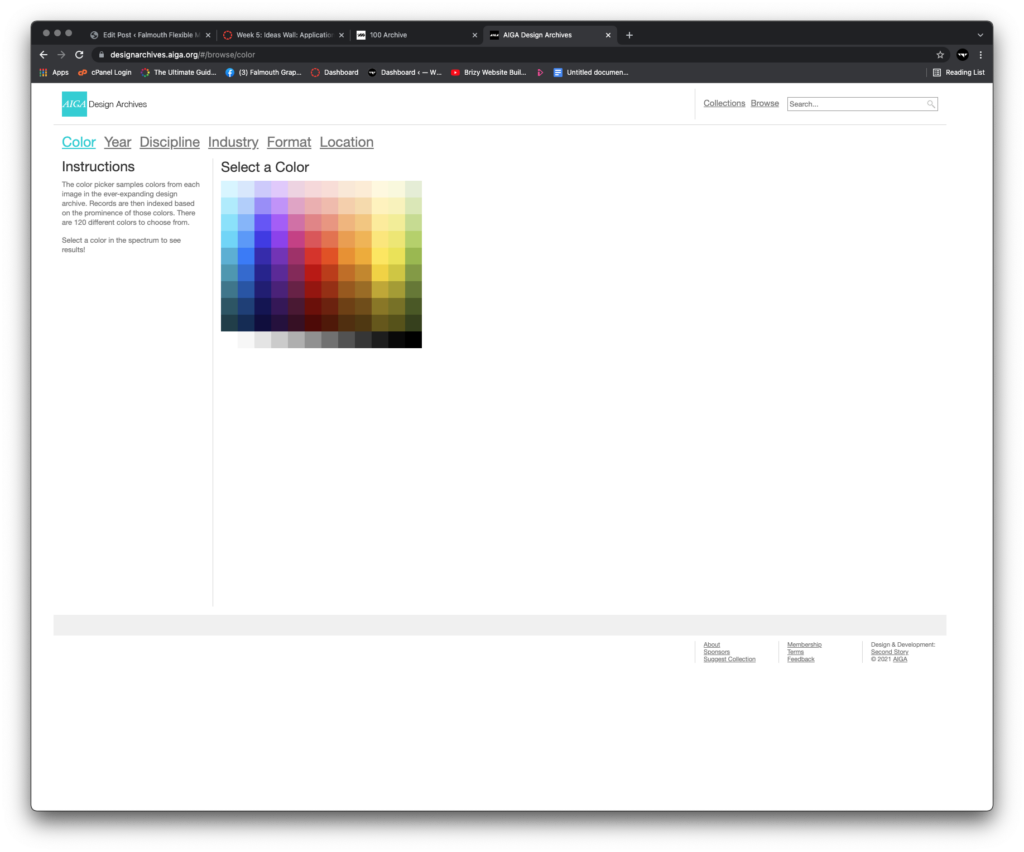
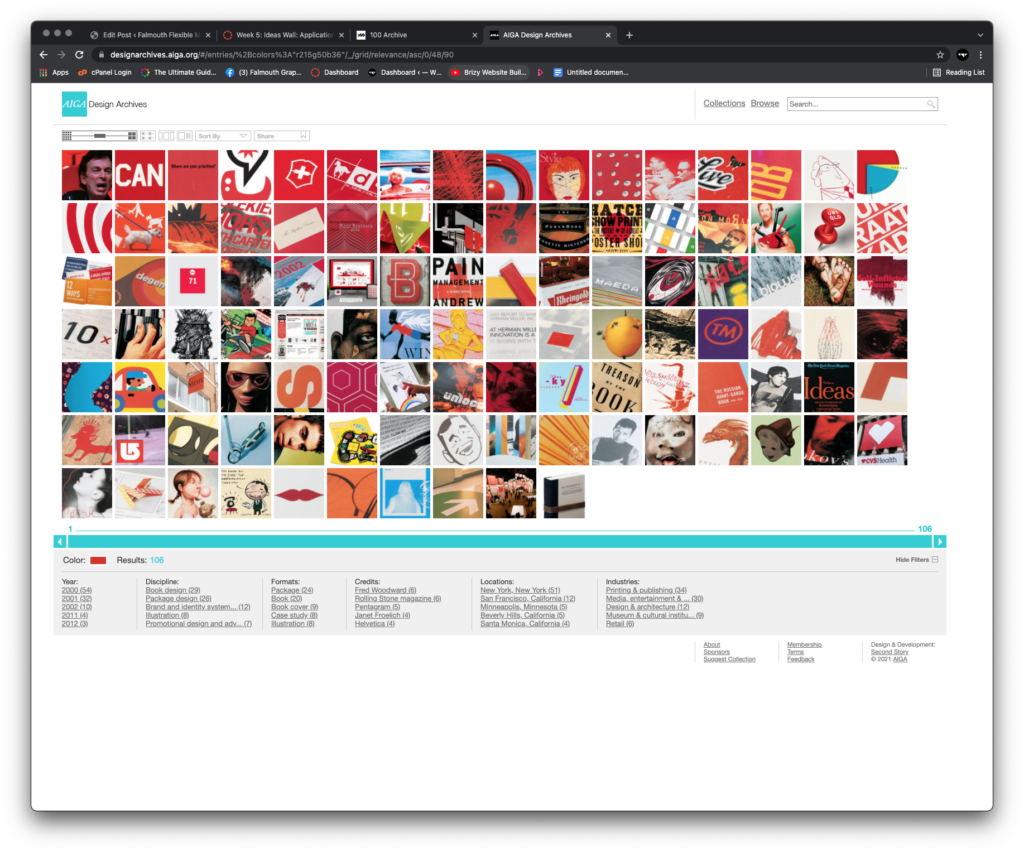
BELOW: Digital Scholarship Lab, object search by location with pictorial reference and active map.
